This problem has frustrated me since mid-2016 after my first Windows-10 upgrade. The Windows-10 machine could not see or connect to my Linux shares no matter what I did. I ended up having to change several things before it finally worked.
Linux smb.conf:
ntlm auth = no
lanman auth = Yes
client ntlmv2 auth = Yes
client lanman auth = Yes
tls enabled = Yes
The last link in the chain for Windows-10 Pro was:
Click Start > All Programs > Accessories > Run and type secpol.msc in the Open box, and then click OK.
Click Local Policies > Security Options > Network Security: LAN Manager authentication level.
Click Send LM & NTLM – use NTLMv2 session security if negotiated.
Click Apply.
On Windows-10 Home:
1. Go to Run, Type Regedit and open this key:
HKEY_LOCAL_MACHINE\SYSTEM\CurrentControlSet\Control\Lsa\
2. If it doesn’t exist, create a DWORD value named
LmCompatibilityLevel
3. Set the value to 5
4. Reboot
Twice I had to have the Mustang towed home this year when it wouldn’t start. The old MSD-6A system finally failed completely the second time. I replaced it with a F.A.S.T. E6 CD Ignition. One appealing feature of the E6 is the ability to run at lower voltages than some of the other system. I like the twisted pair wiring for the magnetic pickup also. It ran well at first, then I started having sever misfire and even what felt like cross-fire issues. Turns out that the plug wires for cylinders #1 and #2 had failed open-circuit. New plugs (NGK platinum this time) and Ford Motorsport 9mm wires cured it.
I have this mounted under-hood since this car is very rarely driven in rain and never in snow. The most water it sees is from my home power-washer.
I added the fuel tank vent through the LR wheel-well, and an alligator clip lead from the base of the throttle body to the negative battery cable. No issues on a 30 mile test-drive. Still tweaking the idle screws to bring the IAC steps into the recommended range.
So far, in about 60 miles of driving, the car has died and been very difficult to restart 3 times. The last time I finally had it hauled home (AAA), and of course it started right up as soon as we got it off the truck. Others seem to be having similar problems:
http://classicbroncos.com/forums/showthread.php?t=263586
Nutshell version: could be weak ground connections?
I have aluminum heads and an aluminum intake, which could result in a weak ground to chassis through the ground strap. I’ve long suspected that grounding issues could explain why the fuel gauge reads 1/4 tank or more low typically.
Other notes about my setup: I used the Tanks, Inc. 22 gal. fuel tank with the 255 LPH in-tank Walbro fuel pump. I used 14ga wire to extend the fuel-pump power wire from roughly the left dash area back to the pump. I used a crimp connector at that junction, with the thought that I will likely add a pump cut-off switch. The pump is grounded to the chassis in the trunk for now. I can hear the pump running when it won’t start, but I confirmed I’m getting no fuel through the injectors. The data log shows that the FiTech ECU is receiving a reasonable tach signal via my my 33 year old MSD-6A when it won’t start, so I’m assuming it’s trying to provide spark. I am not (yet) using the timing control, I have a Ford magnetic pickup vacuum advance distributor feeding the MSD-6A and a new MSD blaster-2 coil.
I’ll experiment with the wiring tomorrow, but with rain forecast all week, it may be awhile before I can drive it enough for more tests.
Finally taking the plunge into EFI. As usual, nothing is easy. I’m using a special EFI fuel tank made by Tanks, Inc. with an in-tank electric pump. Nice, but a couple of glitches. Part of the internal baffles interferes with the fuel gauge.
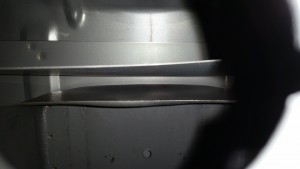
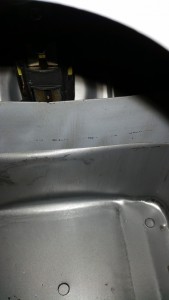
I managed to bend it out of the way enough that I think the gauge will work. Also this tank is based on the 22 gal. ’70 fuel tank, so a different filler neck is required. The installed and partially wired fuel tank is pictured below. The fuel lines run to bulkhead fittings to pass through the trunk floor behind the axle.
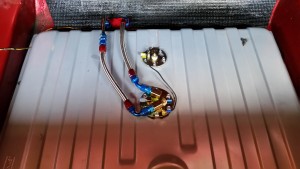
I’m using 3/8″ stainless steel tubing for most of the lines, stainless braided lines in some areas, and “twist-lok” in others. Left rear wheel-well below:
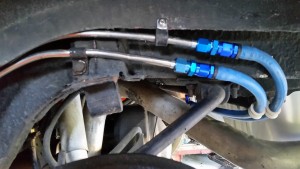
Under drivers side

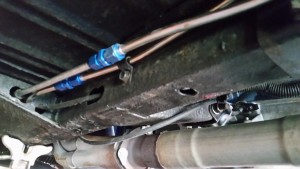
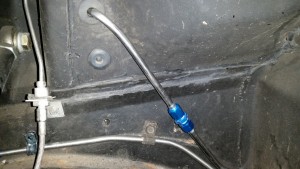
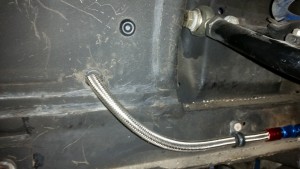 Left front wheel well
Left front wheel well
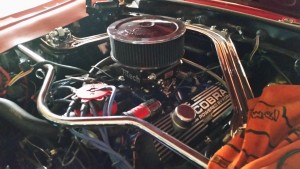 I had trouble getting the 1/4 NPT fittings at the fuel-pump mounting plate to seal until I used Teflon tape. I was able to take it for a test drive (and to buy gas) Sunday June 12th. The difference is unbelievable, even though it hasn’t had time to completely tune itself. During this process, I discovered that the old Crane chrome coil was leaking oil, which likely explains the misfires under hard acceleration (at the drag strip). I replaced it with a MSD coil from Summit Racing. I also discovered that the rear seal on the Tremec transmission was leaking, so I replaced that seal. Transmission oil was leaking onto the exhaust system, and all over the under-side of the car, probably for a year or more.
I had trouble getting the 1/4 NPT fittings at the fuel-pump mounting plate to seal until I used Teflon tape. I was able to take it for a test drive (and to buy gas) Sunday June 12th. The difference is unbelievable, even though it hasn’t had time to completely tune itself. During this process, I discovered that the old Crane chrome coil was leaking oil, which likely explains the misfires under hard acceleration (at the drag strip). I replaced it with a MSD coil from Summit Racing. I also discovered that the rear seal on the Tremec transmission was leaking, so I replaced that seal. Transmission oil was leaking onto the exhaust system, and all over the under-side of the car, probably for a year or more.
I can hear the fuel pump running, although it was much less noticeable after nearly filling the tank. I left the fuel-tank vent plugged for now. Finding a place to route a vent such that it vents outside instead of inside the trunk space seems like a challenge. Maybe I can put it high up in the wheel-well?
6/18/16: After about 60 miles of driving it mostly runs far smoother and much more responsive than ever before; however, I’m having some crank-startup issues, and it has died on me twice. I’ll post my settings when I find a combination that works.




















